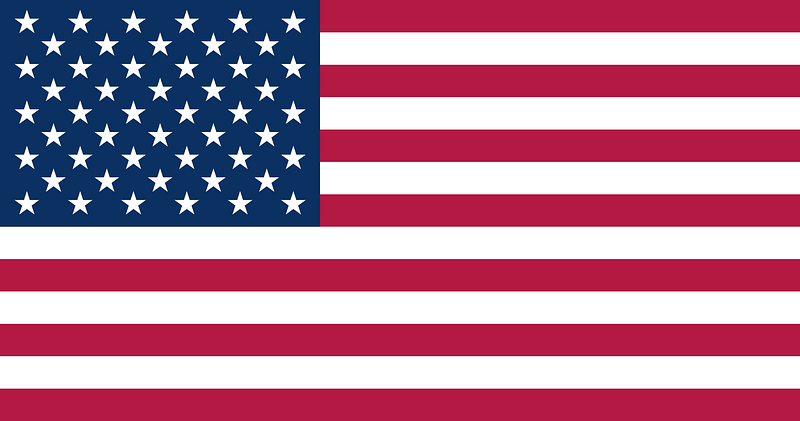This travel wiki page of the United States of America (USA) will help guide travelers with quick and relevant information to consider when planning and visiting the country. It is difficult to find all the relevant information on US culture, safety, travel restrictions, and things to do, so we summarize it all here. If anything is stale or outdated, please let us know! Let’s dive in and explore more high-level information as a USA trip planner.
Last updated December 10th of 2023.
Table of contents
National Information & Culture

The United States of America (USA), commonly known as the United States or America, is the world’s third-largest country. It comprises 50 states, a federal district, five major unincorporated territories, and nine Minor Outlying Islands, including 326 Indian reservations. The U.S. shares land borders with Canada to the north and Mexico to the south. Furthermore, it shares maritime borders with the Bahamas, Cuba, Russia, and other nations.
The national capital is Washington, D.C., while New York City is the most populous city and principal financial center. The U.S. may be a vast country, but it only shares one currency nationwide: the U.S. dollar (USD), with the symbol $.
A world leader and superpower, the U.S. is a highly developed country. It possesses the most immense wealth of any country and accounts for over a quarter of the global GDP. The U.S. is a founding member of the United Nations, the World Bank, the International Monetary Fund, the Organization of American States, NATO, and the WHO. The country is also a member of the G7 and a permanent member of the United Nations Security Council. Moreover, the U.S. is a nuclear-weapon state and has considerable global influence as the world’s foremost political, cultural, economic, military, and scientific power.
In the U.S., it is customary to tip restaurant, hotel, and taxi services at 15-20% of the bill rate. When shopping, note that prices on displayed items do not include sales tax. The actual cost is higher, pending the tax rate, which varies by state and locality. Likewise, punctuality is essential in professional and social settings. Lastly, be mindful of cultural sensitivities, especially regarding topics like race, religion, and politics.
Visit the United States of America Official Tourism website for more information and tips when planning your trip.
Special Travel Considerations

Each country and destination has rules and regulations that every traveler must consider. Hence, check the following considerations for hassle-free travel to the United States.
Covid-19 Policy
Effective May 12, 2023, the United States has ended the travel restrictions related to COVID-19. Hence, travelers no longer need to show proof of vaccination and testing to board a flight to the United States. Check the latest update related to the coronavirus when planning your trip to the U.S.
Travel Insurance
Generally, travel and health insurance are not mandatory but highly recommended for United States visitors. Preferably, it must cover emergency medical treatment, including Covid-19, repatriation, and evacuation. Travel insurance can protect you against the inconvenience of injury, medical emergencies, theft, and flight cancellations. In addition, it is a comprehensive protection in case anything goes wrong with your trip.
Visa Information
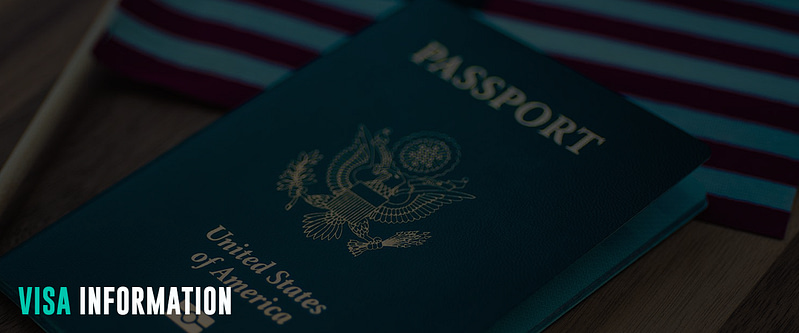
Citizens of countries participating in the Visa Waiver Program can enter the U.S. for tourism or business purposes without obtaining a visa for stays up to 90 days. However, travelers must apply for authorization through the Electronic System for Travel Authorization (ESTA) before boarding a U.S.-bound flight. The ESTA is an automated system that determines the eligibility of visitors to travel to the U.S.
On the other hand, citizens of countries not eligible for the Visa Waiver Program must apply for a US Visa to enter the country. The type of visa will depend on the purpose of their visit, such as tourism, business, or study. The application process generally involves completing the DS-160 form, scheduling a visa interview at a U.S. embassy or consulate, and paying the corresponding visa fees. Travelers can check detailed information and instructions on the U.S. Department of State’s Consular Electronic Application Center website.
Aside from visas, all visitors to the USA must have a passport valid for at least six months longer than their intended stay in the U.S. unless country-specific agreements exempt them.
Popular Attractions
The United States is home to a diverse range of tourist attractions, from natural wonders to iconic landmarks. No wonder it ranks third in the 2023 most-visited countries worldwide.
Grand Canyon National Park
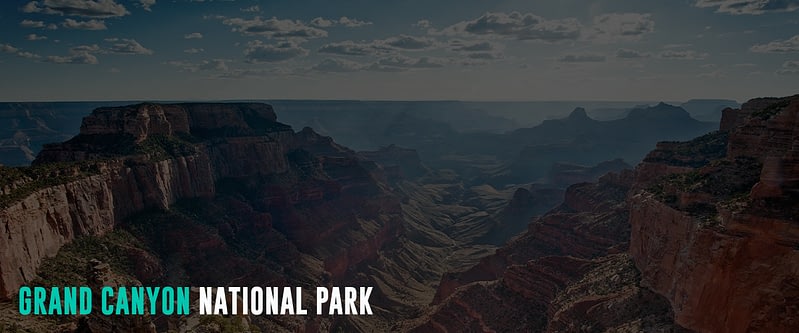
The Grand Canyon National Park in northwestern Arizona is a top tourist attraction in the United States. It remains a captivating natural wonder shaped over millions of years by the Colorado River and spans 277 miles in length and up to 18 miles in width.
As one of the premier tourist attractions in the United States, the Grand Canyon boasts breathtaking natural beauty and geological marvels. Attracting millions of visitors annually, the Grand Canyon offers numerous hiking trails, river rafting along the Colorado River, and scenic viewpoints accessible by car. Moreover, helicopter tours provide a unique aerial perspective of the vast canyon.
The South Rim, accessible year-round, offers diverse activities such as hiking, biking, mule rides, and scenic drives. Park rangers provide insights into its history, and visitors can explore museums and engage in various recreational pursuits. The North Rim is closed from December 1 to May 15 due to winter conditions, providing a different perspective with unique viewpoints. Despite not being the world’s deepest or longest canyon, its size and intricate landscape offer unmatched vistas. Easily accessible from Las Vegas, the South Rim is the most visited section, featuring a large visitor center, bus service, and the famous Skywalk—a glass bridge extending over the canyon. In contrast, the North Rim offers a quieter experience with distinctive viewpoints with limited winter access.
The Grand Canyon National Park offers amenities such as visitor centers, museums, and accommodations for a comfortable and educational experience. For planning activities and accessing information, tourists can visit the official Grand Canyon National Park website or the park’s visitor centers.
Niagara Falls
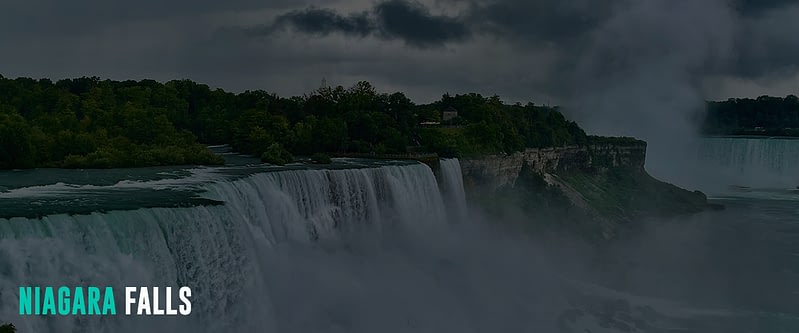
Niagara Falls formed over 12,000 years ago, is a global attraction on the US-Canadian border. This iconic waterfall is the centerpiece of the Niagara Falls State Park, spanning 162 hectares. Niagara Falls, straddling the New York-Ontario border, comprises Horseshoe Falls (on the Canadian side), American Falls, and Bridal Veil Falls.
Surrounding the falls and Niagara River Gorge are lush gardens, historical sites, and 24 kilometers of trails. Visitors can enjoy scenic views from multiple lookout points and a cluster of tours and activities. Head down into Niagara Gorge’s Cave of the Winds to experience the full force of the water from the Hurricane Deck. Visitors can also cruise past the falls via Maid of the Mist, a boat tour that skirts the American Falls base and pulls into the Horseshoe Falls basin. Of course, don’t forget to put on a poncho!
Another famous activity is the helicopter tour or taking the NFNHAa’s Discover Niagara Shuttle, a convenient transportation service from May to September. It is a hop-on/hop-off shuttle to 15 destination stops along the 14-mile route from “the Falls to the Fort.”
With more than 280,000 liters of water plummeting into the Niagara River every second, Niagara Falls is the kind of natural event that commands attention. It represents 20% of the world’s freshwater; Niagara Falls continues to captivate over 8 million annual visitors at the oldest state park in the U.S.
Yellowstone National Park
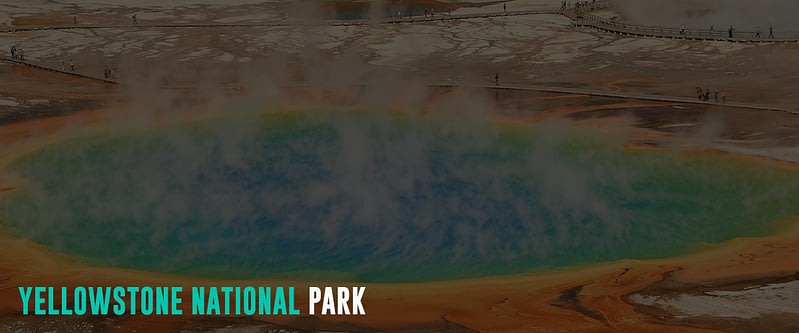
Yellowstone National Park is the first national park established in the U.S. in 1872. It is an iconic destination covering 2.2 million acres across Wyoming, Montana, and Idaho. The park boasts dynamic geothermal features, mountains, rivers, canyons, springs, and geysers, surrounded by diverse wildlife.
Yellowstone lies on a gigantic hotspot, containing half of the world’s geothermal features with over 10,000 geysers and hot springs. A highlight is the iconic Old Faithful, which unpredictably erupts and releases over 3,700 gallons of hot water that captivates visitors.
The park is also home to a vast ancient volcano and showcases attractions like the Grand Canyon of the Yellowstone River and the Mammoth Hot Springs. Moreover, the park’s 2.2 million acres host diverse wildlife, including black and grizzly bears, deer, elk, bison, moose, bighorn sheep, and wolves. It remains a haven for outdoor activities, drawing around 4 million visitors annually to camp, hike, boat, fish, and experience the rich wildlife.
In the summer, crowds gather to witness geothermal wonders, but visiting during the off-season or exploring remote hiking trails provides a quieter experience and a higher chance of spotting wildlife.
National Mall and Monuments
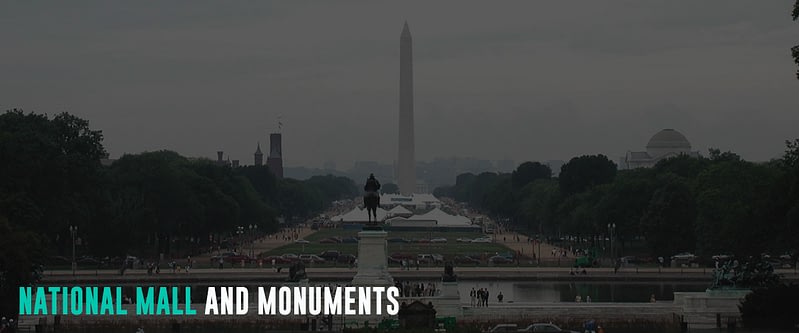
The National Mall and Monuments in Washington, D.C., serve as a tribute to the history of the United States, representing more than 200 years of democratic values. Spanning from the U.S. Capitol Building to the Potomac River, this historic landscape covers about 405 hectares of green space, housing over 80 historic structures and 150 parks, squares, circles, and triangles.
Among the prominent monuments are those dedicated to U.S. presidents like Abraham Lincoln, Franklin D. Roosevelt, and Thomas Jefferson. Visitors will also find memorials honoring those who served in World War I and II, the Korean War, and the Vietnam War. The iconic Washington Monument, a 169-meter marble obelisk, stands tall, offering visitors a 70-second elevator ride to museum exhibits and panoramic city views.
Connecting the Lincoln Memorial and World War II Memorial is the Reflecting Pool, a 618-meter-long and 51-meter-wide expanse ideal for strolls. The National Mall also features the Martin Luther King Jr. Memorial and offers ranger-guided tours for a comprehensive experience. Paddleboating around the Tidal Basin, surrounded by cherry trees, provides a unique perspective.
The National Mall and Memorial Parks encompass over 1,000 acres of must-see monuments, sites, and green spaces maintained by the National Park Service. The two-mile stretch of the National Mall, flanked by the U.S. Capitol and the Lincoln Memorial, attracts around 24 million tourists annually. Aside from memorials, the park includes Smithsonian museums, art galleries, statues, and landmarks, symbolizing the nation’s democratic values. While a day or two is needed to fully explore the National Mall, visitors are encouraged to explore Washington, D.C.’s top museums.
The White House, Washington, D.C.
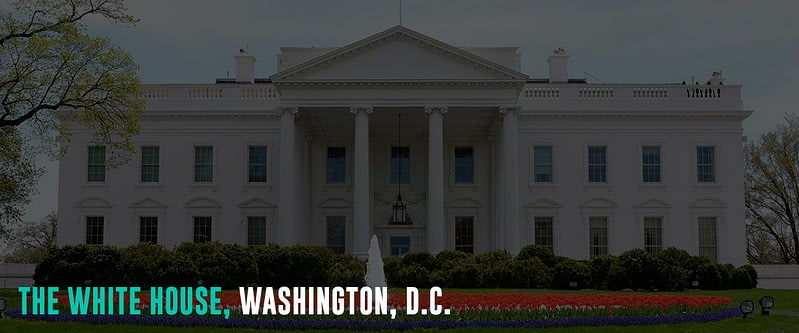
The White House, the official residence and office of the U.S. President, is a must-see in Washington, D.C. Built between 1792 and 1800 by James Hoban, it has been home to every president except George Washington. After being burned down by the British in 1814, it was rebuilt in 1818.
Lafayette Park is An excellent photo stop on the White House’s north side. While visiting the White House has become more challenging post-9/11, tours are now available for groups of 10 or more, requiring requests up to six months in advance through a Member of Congress or a country’s US Ambassador.
Statue of Liberty
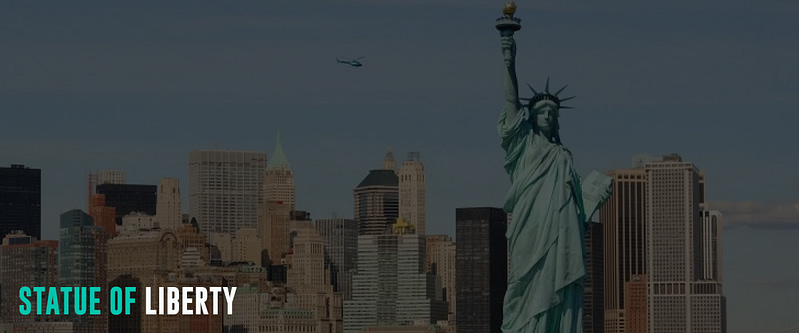
The Statue of Liberty is a colossal neoclassical sculpture on Liberty Island in New York Harbor and stands as a universal symbol of freedom and democracy. A gift from France, designed by sculptor Frédéric Auguste Bartholdi and with a metal framework by Gustave Eiffel, the statue was dedicated on October 28, 1886.
As America’s most familiar icon and the world’s largest statue, it is admired from various points in the city, such as Battery Park. The statue is accessible for tours, allowing visitors to step inside and appreciate its significance as a beacon of freedom. Options for visiting include grounds, pedestal, or crown tickets, and sightseeing tours like the Skip-Line Statue of Liberty & Ellis Island Tour offer a convenient way to experience this symbol of America’s highest-held values.
Golden Gate Bridge, San Francisco
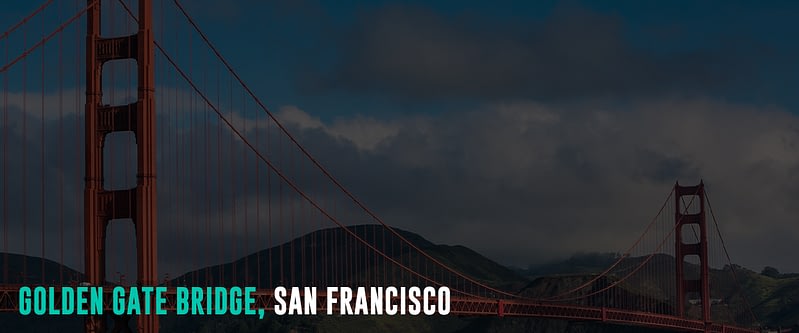
The Golden Gate Bridge is an iconic suspension bridge spanning the Golden Gate Strait and connecting San Francisco with Marin County. The bridge is approximately two miles long and part of Highway 101 or SR 1. It has stood as a San Francisco and California symbol since its completion in the 1930s. Its distinctive orangish-red color contrasts with the blue waters, creating a unique aesthetic accent for the city. The bridge’s fantastic presence in fog and the main towers projecting through low-lying clouds add to its allure. As one of the world’s most beautiful bridges, it boasts tremendous towers, sweeping cables, and a great span, creating a sensory experience of color, light, and sound.
A prime viewing spot is on Conzelman Road in Golden Gate National Recreation Area, attracting over 10 million visitors annually. Whether seen from a beach, a vista overlook, or crossed on foot or bike, the Golden Gate Bridge remains an iconic and essential part of the San Francisco experience.
Las Vegas Strip
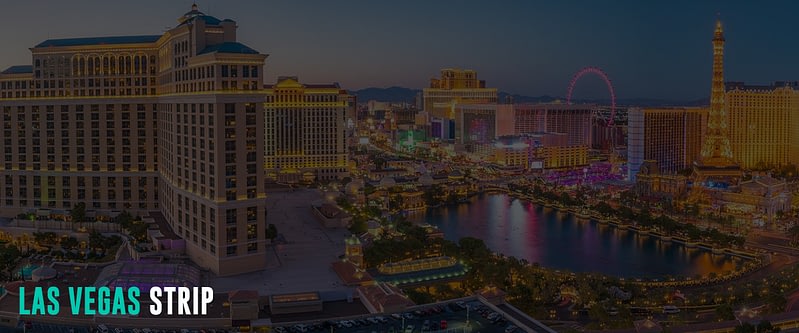
The Las Vegas Strip, or the Las Vegas Boulevard, is an iconic street of upscale casino hotels, vibrant neon lights, and extravagant performances. It has become a symbol of entertainment, from gambling to a multifaceted, world-class destination. Moreover, the expansive hotel complexes host a variety of shops, restaurants, and performance venues featuring music, comedy, and circus-style acts.
Walking along the Strip feels like navigating an adult amusement park. It showcases recreations of global landmarks like the New York skyline and the Eiffel Tower. Attractions like the Fountains of Bellagio and the High Roller observation wheel add to the spectacle. Luxor Hotel, designed as a pyramid, marks the beginning, leading to sights like erupting volcanoes and dancing fountains. Inside the resorts, various oddities and entertainment options abound, many of which are free to experience.
Other must-visit sites are the ‘Welcome to Fabulous Las Vegas, Nevada’ sign; The Park; Public art at City Center; Fall of Atlantis show; LINQ Promenade; Wildlife Habitat at Flamingo Las Vegas; the Mirage Volcano; The Venetian’s canals; Adventuredome; Gold & Silver Pawn Shop; Downtown Container Park; and The Neon Museum.
Beyond the city lights, Las Vegas offers nearby attractions for a change of scenery, making it a versatile destination. Day trips to Death Valley National Park, Hoover Dam, and Valley of Fire State Park offer exploration options for those seeking a break from the nightlife. Hiking trails around Las Vegas, some just minutes from downtown, provide opportunities to explore the nearby desert.
Times Square, New York
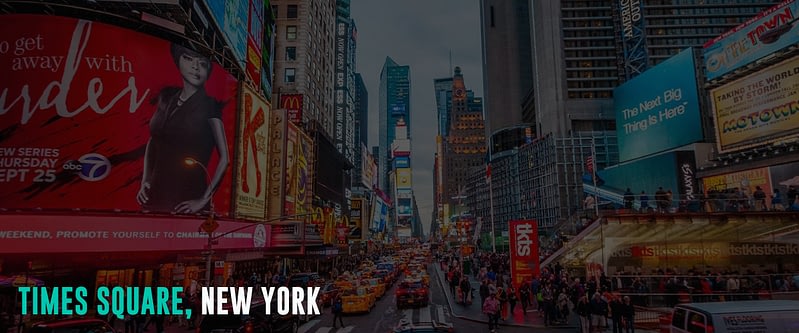
Times Square is a vibrant and iconic destination, a major commercial intersection between Broadway, Seventh Avenue, and 42nd Street in Midtown Manhattan, New York City. It is known for its flashing billboards, the famous New Year’s Eve countdown, and constant crowds. Broadway, the most renowned street in Times Square, is synonymous with the bright lights, beaming advertisements, and colossal billboards that define the area. Cutting through the commercial hub, Broadway forms a bustling town square traversed by hundreds of thousands daily.
Regularly, the intersection pulsates with energy as taxi cabs rush and lights flash overhead, creating a dynamic atmosphere. While attractive during the day, the full impact of Times Square is best experienced at night, when the vibrant lights and bustling energy come alive.
After World War I, Times Square experienced significant growth, evolving into a cultural hub with theaters, music halls, and upscale hotels. It became New York’s agora, a gathering place for various celebrations, from World Series victories to presidential elections.
Waikiki Beach, Hawaii
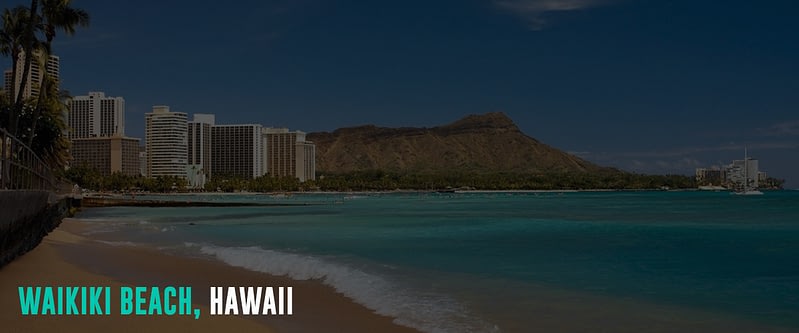
Waikiki is a renowned tourist destination in Oahu, Hawaii. It boasts the most popular beach in the Hawaiian Islands, known for its beauty, surfing, and cultural significance. Over a century old, Waikiki blends tropical paradise and modern city, offering a picturesque stretch of sand with swaying palm trees. Despite the tropical ambiance, the backdrop of high-rise buildings and a bustling street reminds visitors of civilization’s proximity.
Waikiki Beach offers a two-mile stretch of white sand and turquoise water from Hilton Hawaiian Village to Kapi’olani Park. It welcomes over four million visitors annually, providing breathtaking views of Lēʻahi (Diamond Head). Waikiki also encompasses several interconnected beaches, including Duke’s Beach, Kūhiō Beach, and Queen’s Surf Beach.
Beyond its allure, Waikiki holds cultural significance as a former playground of Hawaiian royalty and the birthplace of surfing. Duke Kahanamoku Beach at Waikiki’s western edge is named after the legendary surfer and Olympic swimming champion. It is the widest beach in Waikiki, catering to families and those seeking sun-filled activities like swimming, kayaking, canoeing, and sailing. The Duke Kahanamoku statue symbolizes the beach’s surfing legacy, making it an ideal place to learn to surf or paddle a canoe.
With a tropical climate, high-rises, high-end restaurants, and resorts, Waikiki remains a paradise for swimming, surfing, snorkeling, and various activities worldwide for visitors of all ages.
Primary Spoken Language(s)
The United States does not have an official language at the federal level. However, English is the de facto national language used for official government and legal proceedings. It is also the primary language of instruction in schools.
Local or indigenous languages are recognized alongside English in three states and four U.S. territories. These include Hawaiian in Hawaii, twenty Native languages in Alaska, Sioux in South Dakota, Samoan in American Samoa, Spanish in Puerto Rico, Chamorro in Guam, and Carolinian and Chamorro in the Northern Mariana Islands.
While English is the predominant language spoken in the United States, the country is linguistically diverse due to its multicultural population. As a result, many people speak languages other than English at home. Spanish is the second most spoken language in the United States and is spoken by a large portion of the population, particularly in states with significant Hispanic communities.
Other languages spoken in the U.S. include Chinese (including Mandarin and Cantonese), Tagalog, Vietnamese, Arabic, and French, among others. The linguistic landscape of the United States reflects its rich cultural diversity, with many languages spoken across different communities.
Safety Concerns
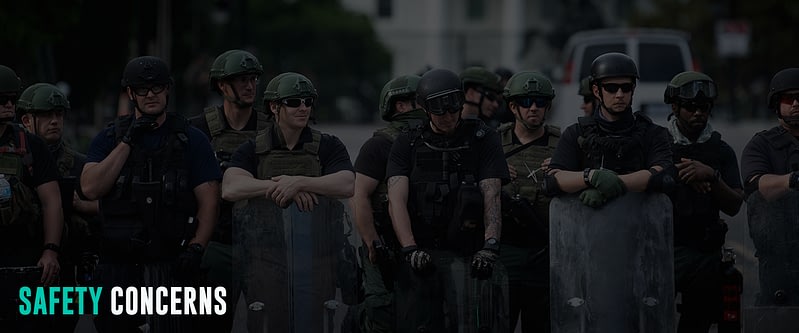
The U.S. is a vast country with 50 states in different time zones. Like other big and developed countries, the U.S. has faced increasing crime rates. News and statistics about the U.S. gun culture say the country has the highest rate of death by guns in developed countries. The media also sensationalizes news on mass shootings, gun violence, police brutality, and racism. This creates the perception that the U.S. is a dangerous and unwelcoming country.
But despite all of these, the U.S. is safe to visit for tourists. As a matter of fact, the country ranks fourth as the world’s most-visited country in 2023. Travelers only need to take precautions and practice common sense as they would anywhere else.
Crimes and Violence
Violent crimes, gun-related incidents, and hate crimes are increasing in the U.S. Statistics from the Federal Bureau of Investigation (FBI) say violent crime rates vary across the country but are highest in cities and urban areas. Although tourists are rarely targeted, it still pays to be vigilant. Note that there is always a risk of being in the wrong place at the wrong time. Hence, research the destination before traveling. Stay alert when moving through unfamiliar and potentially unsafe areas, particularly at night.
Petty crime are also prevalent in the major cities and high-tourist areas. Thefts and pickpockets often target tourists in crowded areas and public transport. So, keep valuables and pay attention to personal belongings. Only carry what you need and leave other valuables in a secure location.
Car theft and break-ins are also a concern in the U.S. Rental cars are often a target of thieves. Hence, always lock the car door before leaving. Do not leave valuables on display in a vehicle, including in the boot (the trunk).
Lastly, avoid areas with demonstrations and protests. It has the potential for unrest and violence and may be targeted by terrorists. Be mindful of the surroundings and move away if there are signs of trouble.
In case of emergency, dial the national hotline number, 911. It is toll-free and connects callers to police, fire department, and ambulance — if necessary. Other significant numbers to note are 411 for local phone directory assistance and 511 for traffic/construction on highways.
Natural Hazards
The United States experiences various natural disasters throughout the year. Tornadoes can affect all 50 states any time of the year but are common in the Midwest and South during the spring, particularly from March to September. A significant portion of tornado activity occurs in the Tornado Alley, including parts of Texas, Oklahoma, Kansas, Nebraska, and South Dakota.
On the other hand, hurricane season spans from June to November along the Atlantic and Gulf of Mexico coastlines. Susceptible to hurricanes include the states of Texas, Louisiana, Mississippi, Alabama, Florida, and the coastal areas of the Carolinas.
Wildfires are most prevalent in the West during the summer, but their intensity can extend into the fall. Winter brings heavy snow to northern and northeastern states, though snow cover is not constant. Nonetheless, the U.S. has a sophisticated emergency management system involving federal, state, and local governments to address these natural disasters. In case of floods, tornadoes, hurricanes, or earthquakes, an intricate response mechanism is activated.
Check out weather alerts and forecasts from the National Weather Service. Likewise, travelers can visit the Storm Prediction Center and the National Hurricane Center websites when planning an itinerary and traveling to the U.S.
Local Laws
The U.S. has severe penalties and consequences for drug violations. Travelers bringing medications to the U.S. must carry doctor’s prescriptions. Some prescription and over-the-counter medications in your home country might be illegal in the U.S. Notably, narcotics and certain other drugs with a high potential for abuse, such as Rohypnol, GHB, and Fen-Phen, to name a few, are illegal and prohibited in the United States.
Hence, check local drug laws, including the recreational and or medical use of marijuana, as it varies between states. Likewise, some states have laws restricting access to abortion and other reproductive health care services. Research local laws and consult a doctor before deciding on medical care.
Budget Considerations
The U.S. is so vast that the prices vary greatly depending on the state and region. Expect higher prices in bigger cities and during peak season. Hence, it is best to research and plan the destinations anyone wants to visit in the U.S. The country is accessible and open to all types of travelers, although it is not a popular destination choice for backpackers and budget travelers.
Accommodation

The accommodation cost in the U.S. mainly varies depending on the location. Hostels are available in most cities, but chances of finding one in the suburbs are slim.
But generally, a bed in a hostel dorm starts at $26 in Los Angeles and Miami, $35 in New York, and $21 in Las Vegas. Private hostel rooms cost between $55 and $70. Free Wi-Fi is standard, and most hostels have self-catering facilities.
In addition, travelers will find Airbnb apartments and holiday homes between $40 and $100. Likewise, visitors looking for more comfort can stay in a three-star hotel for around $150 and $250 for a five-star hotel in New York. Prices are lower in Las Vegas at about $180 for a five-star hotel, while they range to over a thousand dollars in Beverly Hills.
Meanwhile, expect to pay $10 to $30 per night for a basic tent plot in public campgrounds managed by the National Park Service, the Bureau of Land Management, or state park systems. Likewise, travelers can also check campsite availabilities and reservations from the Recreation.gov portal.
Food
Foods in the U.S. are diverse and relatively cheap. Notably, every region and state has its staple, from barbecue in Texas to seafood in the coastal states. However, since the U.S. is vast, food prices vary significantly, with 25% higher prices in coastal cities and metropolises.
Sandwiches cost around $7, while fast food combo meal costs $9. Travelers can also get food truck meals between $10 and $15, while Asian meals start at $10. Meanwhile, mid-range restaurants cost around $25 for a meal with a drink. Travelers who want to splash out on meals can expect to spend at least $60 per person on fine dining, and the sky is the limit for luxury!
For self-catering, expect to pay about $60 weekly for basic staples like rice, pasta, vegetables, and meat. But again, expect higher prices in larger cities.
Attractions and Transportation
While some attractions and U.S. parks are free, travelers must pay admission fees when visiting and camping in most national parks. Visiting Niagara Falls is free, while admission and camping at the Grand Canyon National Park and Yellowstone National Park ranges between $20 per person, $30 per motorcycle, and $35 for vehicles up to 15-person capacity. American citizens travelers can also get annual passes when planning multiple visits in one park for $70 or $80 for three parks. Visit the National Park Service portal for more details and information on admission fees.
U.S. public transportation ranges between $1.75 and $2.75, depending on the location and travel distance. Expect to pay at least $40 when renting a car to take a road trip to the best destinations in the U.S.
Average Two-Week Cost
Generally, budget travelers in the U.S. can live with a $75 daily budget or $1050 for two weeks. The budget covers the costs of sleeping in hostel dorm beds, dining at cheap restaurants and street stalls, taking public transport, mainly doing free activities, and visiting cheap tourist sites.
On the other hand, mid-range travelers spend at least $220 daily or $3080 for two weeks. It includes staying in an Airbnb apartment or three-star hotel room, taking occasional taxis, dining in local restaurants, doing a few paid activities, and visiting several attractions.
Lastly, travelers can enjoy luxury and privacy in America from $350 daily to $4900 for two weeks. It includes staying in five-star hotels, splashing out on meals, taking domestic flights, and renting a car or RV for transport. They can also avail of all the paid tours and activities they want. So, for them, the sky is the limit for travel.
Customs And Import Restrictions
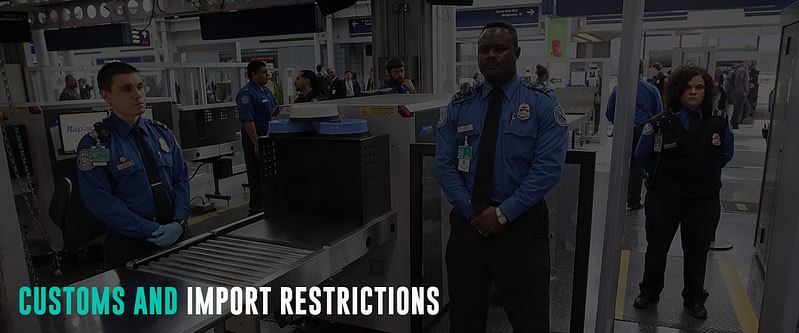
Travelers to the U.S. have personal exemptions and can bring in duty-free items as follows:
- 200 cigarettes and 100 cigars per individual 18 years and older
- One (1) liter of alcoholic beverages per individual 21 years and older
- Gifts and purchases valued at a maximum of $100 total.
Notably, travelers must declare cash of $10,000 or more to customs, whether in U.S. or other currency. To avoid inconvenience, penalties, detention, and possible prosecution, do not bring prohibited and restricted items into the U.S. These include the following:
- Counterfeit goods
- Cuban cigars
- Agricultural (plant and meat) products
- Firearms
- Cultural artifacts and property
- Automobiles
- Drugs and drug-related equipment.
Visit the U.S. Customs and Border Protection website for complete customs duty information and the list of restricted and prohibited items in the country.
Climate Considerations
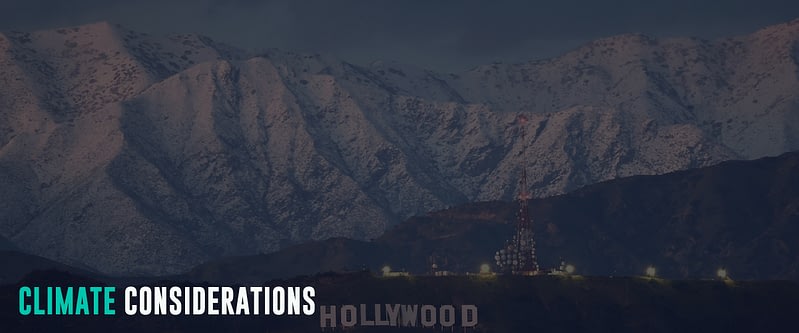
The weather and climate in the United States vary significantly due to its vast size, diverse geography, season, and location. The country generally experiences a range of climates, including temperate, arid, tropical, and polar climates. Also, it has four seasons: summer (June-August), autumn (September-November), winter (December-February), and spring (March-May).
Along the Atlantic Ocean, the eastern part of the United States typically has a humid subtropical climate. Summers are warm and humid, with average temperatures ranging from 21°C to 32°C. Winters are generally mild, with temperatures around -1°C to 10°C.
The Midwest has a diverse climate, with hot summers and cold winters. Summer temperatures can reach 27°C to 35°C, while winter temperatures often drop to -6 °C to -1 °C.
Southern states like Texas and Florida experience a hot and humid climate. Summers are scorching, with temperatures often exceeding 38°C. Winters are mild, with temperatures ranging from 10°C to 21°C.
On the west, the Rocky Mountains and the Sierra Nevada have a mountainous climate with cooler temperatures. Summers are mild, averaging around 16°C to 27°C, while winters can be cold, with temperatures often dropping below freezing.
The Southwest, including Arizona and Nevada, has a desert climate. Summers can be scorching, with temperatures soaring above 38°C. Winters are mild, with daytime temperatures ranging from 16°C to 21°C.
The Pacific Northwest, including states like Washington and Oregon, has a marine climate with mild temperatures. Summers are pleasant, with temperatures around 16°C to 24°C. Meanwhile, winters are cool, ranging from 4°C to 10°C.
Up north, Alaska experiences a subarctic and arctic climate. Winters are icy, with temperatures often dropping below freezing, while summers are short and cool, ranging from 10°C to 21°C.
Lastly, Hawaii has a tropical climate, with consistently warm temperatures year-round. Average temperatures range from 24°C to 29°C.
Hurricane Season
The United States experiences a notable hurricane season, particularly in states bordering the Gulf of Mexico. This region, including states like Texas, Louisiana, Mississippi, Alabama, and Florida, is prone to hurricanes during the official hurricane season, typically from June 1 to November 30.
The Atlantic hurricane season, during which hurricanes can also impact the eastern seaboard, sees an increased likelihood of tropical storms and hurricanes making landfall. Coastal areas from Florida to the Carolinas are particularly susceptible.
Moreover, tornadoes are a common weather phenomenon in the United States, and a significant portion of tornado activity occurs in an area known as Tornado Alley. Tornado Alley includes parts of Texas, Oklahoma, Kansas, Nebraska, and South Dakota. These states are characterized by frequent tornado occurrences, especially during the spring and early summer when atmospheric conditions are conducive to tornado formation.
The overall vulnerability to extreme weather events, including hurricanes and tornadoes, contributes to the United States experiencing more high-impact severe weather incidents than any other country. Additionally, in the American Southwest, the 21st century has witnessed increased frequency and severity of droughts, indicating a broader pattern of evolving weather extremes in the country.
Primary Transportation Options
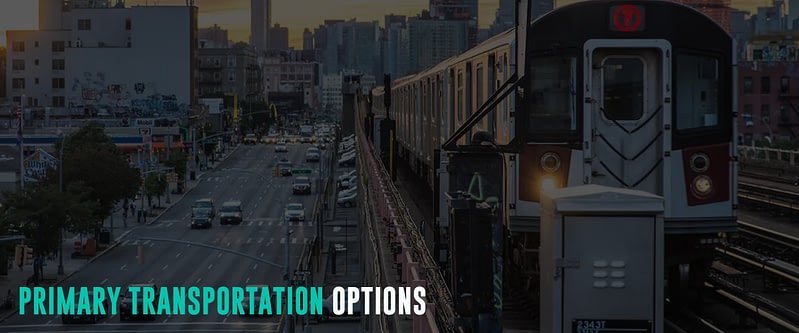
The transportation system in the United States is extensive, diverse, and developed. Hence, travelers to the U.S. are lucky to have various options for exploring the country’s attractions and destinations.
Air
America boasts over 5,500 public airports, with international airports handling flights outside the country. The Transportation Security Administration (TSA) oversees airport safety and conducts luggage inspections if needed.
In addition, the U.S. has an extensive domestic air system, with numerous airlines and thousands of daily flights. Major hub airports serve as international gateways in larger cities, with smaller towns accessible through these hubs. Although the US doesn’t have a flag carrier, the major airlines are Delta, American, and United Airlines. But to save money, consider budget carriers like Avelo and Breeze, which offer low fares but often serve less convenient airports.
For efficient travel between regions, flights are a viable option despite being more expensive than other modes of transportation.
Boat and Ferry
Travelers can explore unique islands off the US coast by hopping on coastal ferry services, typically run by the state. These efficient and often photogenic ferries link to significant islands, with many larger ones accommodating private cars, motorcycles, and bicycles.
Consider the ferry and cruises along Alaska’s southeastern coast and through the Inside Passage for stunning views. In the Pacific, ferries serve Washington’s scenic San Juan Islands and California’s hiker-friendly Catalina Island. In the Midwest, boat trips can take you to islands in the Great Lakes, such as Mackinac Island, Michigan, and the Apostle Islands of Wisconsin. On the East Coast, ferries connect passengers to upscale enclaves like Nantucket and Martha’s Vineyard in Massachusetts and the rugged Ocracoke Island in North Carolina. Notable ferry routes and companies include the Alaska Marine Highway System, Staten Island Ferry, Shepler’s Mackinac Island Ferry, Cape May-Lewes Ferry, Washington State Ferries, New Orleans Ferry, Golden Gate Ferry, and Steamship Authority.
Recreational boating is also popular in the U.S., attracting over 87 million participants annually. River cruises, such as paddle-wheel cruises down the Mississippi River, offer stops at iconic destinations like St. Louis, Memphis, and New Orleans. Coastal city tours, whale watching, and boat rentals along coastlines and lakes provide additional maritime experiences. Be sure to follow local laws and rules for boat safety when charting your own course.
Rail
Discover the beauty of the United States by embarking on popular train routes and exploring its expansive landscapes. Amtrak, the primary train service, covers 46 states and Washington, D.C., with over 500 destinations. Amtrak provides a stress-free travel experience, featuring wide seats, complimentary Wi-Fi, restrooms, and food services. Long-distance routes like the California Zephyr and Vermonter showcase diverse landscapes and historic towns. Consider the Alaska Railroad for a unique journey connecting Alaskan destinations such as Anchorage, Fairbanks, and Denali National Park.
Many American cities also have commuter rail systems, facilitating travel between towns and suburbs, with connections to local train stations. Amtrak’s high-speed Acela Train offers exclusive and scenic trains often powered by historic steam locomotives. While Amtrak excels along the eastern seaboard, its long-distance routes provide breathtaking scenery, connecting major cities and smaller towns. Notably, thruway buses connect rail networks with smaller cities and national parks.
Amtrak’s USA Rail Passes provide flexibility, covering various travel segments in 15, 30, or 45 days. The Amtrak mobile app allows convenient ticket booking and information access. Check out the Amtrak National Route Map and Destinations when planning train travel in the U.S.
Car Rental
Renting a vehicle in the USA provides unparalleled freedom for travelers, offering the flexibility to make unplanned stops and explore roadside attractions. With 75,439 km of interstate highways, road trips become an adventurous way to see the country.
The robust highway system allows for efficient travel, including free and tolled roadways. Toll payments can be made by cash, credit card, or electronic passes, often provided by rental companies. Conveniently located rental car agencies, such as Advantage, Alamo Rent-A-Car, Avis, Budget, Dollar, Enterprise, Hertz, National, Payless, and Thrifty.
For a unique travel experience, consider RV rentals or motorcycle rentals. RVs offer a home away from home, reducing accommodation costs with thousands of RV parks and campgrounds available. Popular RV rental companies include Cruise America and USA RV Rentals.
Motorcycle enthusiasts can also opt for rentals from companies like EagleRider and Harley-Davidson. Both provide opportunities for scenic tours across the country. Ensure compliance with helmet laws and other regulations.
Another transport option in the U.S. is bicycle rentals. Bicycles provide an inexpensive way to explore big cities, with designated bike lanes in major cities. Bike rental programs are available in over 50 cities, allowing flexible exploration with hourly or daily rentals.
Depending on the car type and model, rental rates start at $40 daily. Major car rental companies also provide hybrid or electric cars at a higher cost. Electric vehicles are gaining popularity, with charging stations becoming more widespread. Camper vans, including Mercedes Sprinters, are a rising rental option, offering comfort and amenities for a unique travel experience.
When driving around the U.S., remember to stay on the right side of the road. Be aware of fuel practices and payment, understand disabled parking regulations, avoid hitchhiking on interstate highways, watch out for wildlife, and obey school bus regulations.
Bus
Traveling by bus is an affordable and popular option, connecting major and minor American cities around the clock. Major bus companies like FlixBus, Greyhound, Jefferson Lines, Megabus, Peter Pan, and Trailways offer reasonable prices, free Wi-Fi, comfortable seating, onboard restrooms, and reclining seats.
Greyhound is a major long-distance bus company operating throughout the U.S. and Canada, with routes following significant highways and connecting larger population centers. Trailways Transportation System comprises about 70 independent bus companies, providing interlining services with route search and ticket management on their website. Other long-distance bus lines with affordable fares and free Wi-Fi include Jet Bus, which links Washington, DC, and New York City (NYC), and the Hampton Jitney, connecting NYC with the Hamptons and the North Fork.
Despite eliminating some small destinations, non-express Greyhound buses stop every 50 to 100 miles, and long-distance buses have meal breaks and driver changes. While many bus stations are safe, some may be in sketchy areas, especially at night. Taxis or ride-shares may be advisable in such cases. Some towns have flag stops, not always in walkable areas.
Public Transport
The public transit systems in the U.S., particularly subways and light-rail trains, are safe, cheap, efficient, and easy to navigate. They are also reliable, with extensive systems in major cities like New York, Chicago, Boston, Washington, D.C., San Francisco, Philadelphia, Los Angeles, and Atlanta. Light-rail systems are also popular in cities like Denver, Seattle, San Diego, Minneapolis, Portland, Phoenix, Tucson, and Charlotte. Other cities have smaller transit systems using buses and trolleys.
Generally, subways have a base fare ranging from $1.75 to $2.75. Passes are also available for extended visits.
Another widely used public transport within most cities is taxicabs. They are convenient and reliable, with costs depending on distance and time. Prepare to pay in cash, although some cabs accept credit cards. A cheaper alternative for taxis in the U.S. is the ride-hailing app services like Uber and Lyft. They are popular nationwide, offering private rides through smartphone apps.
Travelers can also avail of complimentary shuttles to major sites inside U.S. national parks, including Acadia, Grand Canyon, Yosemite, and Zion.
Start Trip Planning

Travel-Wise is made from the ground up to help people travel more, break down the barriers that make it tough to get going, and start your journey as painlessly as possible. Bookmark our other Country Guides to help kick-start your research for future travels. We also offer templated itineraries from our staff and community that help serve as a building block for your trip plans. Alternatively, we also utilize AI to offer a way to generate itinerary ideas. This saves much time just getting you up and running with a template. From there, you can use the trip planner to create your customized itinerary, invite friends and family for collaboration, find others from Travel-Wise to join the trip, book and track important information, journal, and share your experiences at the end or along the way!

